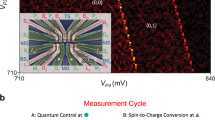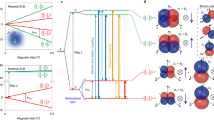Abstract
Coherent dressing of a quantum two-level system provides access to a new quantum system with improved properties—a different and easily tunable level splitting, faster control and longer coherence times. In our work we investigate the properties of the dressed, donor-bound electron spin in silicon, and assess its potential as a quantum bit in scalable architectures. The two dressed spin-polariton levels constitute a quantum bit that can be coherently driven with an oscillating magnetic field, an oscillating electric field, frequency modulation of the driving field or a simple detuning pulse. We measure coherence times of  and
and  , one order of magnitude longer than those of the undressed spin. Furthermore, the use of the dressed states enables coherent coupling of the solid-state spins to electric fields and mechanical oscillations.
, one order of magnitude longer than those of the undressed spin. Furthermore, the use of the dressed states enables coherent coupling of the solid-state spins to electric fields and mechanical oscillations.
This is a preview of subscription content, access via your institution
Access options
Subscribe to this journal
Receive 12 print issues and online access
$259.00 per year
only $21.58 per issue
Buy this article
- Purchase on Springer Link
- Instant access to full article PDF
Prices may be subject to local taxes which are calculated during checkout




Similar content being viewed by others
References
Mollow, B. R. Power spectrum of light scattered by two-level systems. Phys. Rev. 188, 1969–1975 (1969).
Xu, X. et al. Coherent optical spectroscopy of a strongly driven quantum dot. Science 317, 929–932 (2007).
Baur, M. et al. Measurement of Autler–Townes and Mollow transitions in a strongly driven superconducting qubit. Phys. Rev. Lett. 102, 243602 (2009).
London, P. et al. Detecting and polarizing nuclear spins with double resonance on a single electron spin. Phys. Rev. Lett. 111, 067601 (2013).
Hartmann, S. R. & Hahn, E. L. Nuclear double resonance in the rotating frame. Phys. Rev. 128, 2042–2053 (1962).
Cai, J., Jelezko, F., Plenio, M. B. & Retzker, A. Diamond-based single-molecule magnetic resonance spectroscopy. New J. Phys. 15, 013020 (2013).
Timoney, N. et al. Quantum gates and memory using microwave-dressed states. Nature 476, 185–188 (2011).
Laucht, A. et al. Electrically controlling single-spin qubits in a continuous microwave field. Sci. Adv. 1, 1500022 (2015).
Dreher, L. et al. Electroelastic hyperfine tuning of phosphorus donors in silicon. Phys. Rev. Lett. 106, 037601 (2011).
Jonathan, D., Plenio, M. & Knight, P. Fast quantum gates for cold trapped ions. Phys. Rev. A 62, 042307 (2000).
Rabl, P. et al. Strong magnetic coupling between an electronic spin qubit and a mechanical resonator. Phys. Rev. B 79, 041302 (2009).
Mikelsons, G., Cohen, I., Retzker, A. & Plenio, M. B. Universal set of gates for microwave dressed-state quantum computing. New J. Phys. 17, 053032 (2015).
Cai, J., Cohen, I., Retzker, A. & Plenio, M. B. Proposal for high-fidelity quantum simulation using a hybrid dressed state. Phys. Rev. Lett. 115, 160504 (2015).
Pla, J. J. et al. A single-atom electron spin qubit in silicon. Nature 489, 541–545 (2012).
Itoh, K. M. & Watanabe, H. Isotope engineering of silicon and diamond for quantum computing and sensing applications. MRS Commun. 4, 143–157 (2014).
van Donkelaar, J. et al. Single atom devices by ion implantation. J. Phys. 27, 154204 (2015).
Morello, A. et al. Architecture for high-sensitivity single-shot readout and control of the electron spin of individual donors in silicon. Phys. Rev. B 80, 081307(R) (2009).
Morello, A. et al. Single-shot readout of an electron spin in silicon. Nature 467, 687–691 (2010).
Dehollain, J. P. et al. Nanoscale broadband transmission lines for spin qubit control. Nanotechnology 24, 015202 (2013).
Abragam, A. The Principles of Nuclear Magnetism Vol. 32 (Oxford Univ. Press, 1961).
Vandersypen, L. & Chuang, I. NMR techniques for quantum control and computation. Rev. Modern Phys. 76, 1037–1069 (2005).
Jelezko, F. et al. Observation of coherent oscillation of a single nuclear spin and realization of a two-qubit conditional quantum gate. Phys. Rev. Lett. 93, 130501 (2004).
Koppens, F. H. L. et al. Driven coherent oscillations of a single electron spin in a quantum dot. Nature 442, 766–771 (2006).
Press, D., Ladd, T. D., Zhang, B. & Yamamoto, Y. Complete quantum control of a single quantum dot spin using ultrafast optical pulses. Nature 456, 218–221 (2008).
Muhonen, J. T. et al. Storing quantum information for 30 seconds in a nanoelectronic device. Nat. Nanotech. 9, 986–991 (2014).
Veldhorst, M. et al. An addressable quantum dot qubit with fault-tolerant control fidelity. Nat. Nanotech. 9, 981–985 (2014).
Kroner, M. et al. Rabi splitting and ac-Stark shift of a charged exciton. Appl. Phys. Lett. 92, 031108 (2008).
Wu, F. Y., Grove, R. E. & Ezekiel, S. Investigation of the spectrum of resonance fluorescence induced by a monochromatic field. Phys. Rev. Lett. 35, 1426–1429 (1975).
Astafiev, O. et al. Resonance fluorescence of a single artificial atom. Science 327, 840–843 (2010).
Jeschke, G. Coherent superposition of dressed spin states and pulse dressed electron spin resonance. Chem. Phys. Lett. 301, 524–530 (1999).
Laucht, A. et al. Breaking the rotating wave approximation for a strongly-driven, dressed, single electron spin. Preprint at http://arxiv.org/1606.02380 (2016).
Nakamura, Y., Pashkin, Y. A. & Tsai, J. Coherent control of macroscopic quantum states in a single-Cooper-pair box. Nature 398, 786–788 (1999).
DiVincenzo, D. P., Bacon, D., Kempe, J., Burkard, G. & Whaley, K. B. Universal quantum computation with the exchange interaction. Nature 408, 339–342 (2000).
Petta, J. R. et al. Coherent manipulation of coupled electron spins in semiconductor quantum dots. Science 309, 2180–2184 (2005).
Hanson, R. & Burkard, G. Universal set of quantum gates for double-dot spin qubits with fixed interdot coupling. Phys. Rev. Lett. 98, 050502 (2007).
Ithier, G. et al. Decoherence in a superconducting quantum bit circuit. Phys. Rev. B 72, 134519 (2005).
Yan, F. et al. Rotating-frame relaxation as a noise spectrum analyser of a superconducting qubit undergoing driven evolution. Nature Commun. 4, 2337 (2013).
Loretz, M., Rosskopf, T. & Degen, C. Radio-frequency magnetometry using a single electron spin. Phys. Rev. Lett. 110, 017602 (2013).
Hahn, E. L. Spin echoes. Phys. Rev. 80, 580–594 (1950).
Meiboom, S. & Gill, D. Modified spin-echo method for measuring nuclear relaxation times. Rev. Sci. Instrum. 29, 688–691 (1958).
Xu, X. et al. Coherence-protected quantum gate by continuous dynamical decoupling in diamond. Phys. Rev. Lett. 109, 070502 (2012).
Golter, D. A., Baldwin, T. K. & Wang, H. Protecting a solid-state spin from decoherence using dressed spin states. Phys. Rev. Lett. 113, 237601 (2014).
Cai, J. et al. Robust dynamical decoupling with concatenated continuous driving. New J. Phys. 14, 113023 (2012).
Zhang, J., Souza, A. M., Brandao, F. D. & Suter, D. Protected quantum computing: interleaving gate operations with dynamical decoupling sequences. Phys. Rev. Lett. 112, 050502 (2014).
Wang, Z.-H. et al. Effect of pulse error accumulation on dynamical decoupling of the electron spins of phosphorus donors in silicon. Phys. Rev. B 85, 085206 (2012).
Álvarez, G. A. & Suter, D. Measuring the spectrum of colored noise by dynamical decoupling. Phys. Rev. Lett. 107, 230501 (2011).
Kane, B. E. A silicon-based nuclear spin quantum computer. Nature 393, 133–137 (1998).
Franke, D. P. et al. Interaction of strain and nuclear spins in silicon: quadrupolar effects on ionized donors. Phys. Rev. Lett. 115, 057601 (2015).
Barfuss, A., Teissier, J., Neu, E., Nunnenkamp, A. & Maletinsky, P. Strong mechanical driving of a single electron spin. Nat. Phys. 11, 820–824 (2015).
Soykal, O. O., Ruskov, R. & Tahan, C. Sound-based analogue of cavity quantum electrodynamics in silicon. Phys. Rev. Lett. 107, 235502 (2011).
Gustafsson, M. V. et al. Propagating phonons coupled to an artificial atom. Science 346, 207–211 (2014).
Bennett, S. D. et al. Phonon-induced spin–spin interactions in diamond nanostructures: application to spin squeezing. Phys. Rev. Lett. 110, 156402 (2013).
Acknowledgements
This research was funded by the Australian Research Council Centre of Excellence for Quantum Computation and Communication Technology (project number CE110001027) and the US Army Research Office (W911NF-13-1-0024). We acknowledge support from the Australian National Fabrication Facility and from the laboratory of R. Elliman at the Australian National University for the ion-implantation facilities. The work at Keio was supported by the Japanese Society for the Promotion of Science JSPS KAKEN (S) and the Core-to-Core Program.
Author information
Authors and Affiliations
Contributions
A.L., R.K., S.S., J.P.D., J.T.M., A.S.D. and A.M. designed the experiments. A.L. performed the measurements and analysed the results with A.M.'s supervision and R.K.'s and S.S.'s assistance. A.L. and F.A.M. performed the simulations with A.M.'s supervision. D.N.J. and J.C.M. designed and performed the 31P implantation experiments. F.E.H. fabricated the device with A.S.D.'s supervision and R.K.'s and S.F.'s assistance. K.M.I. prepared and supplied the 28Si epilayer wafer. A.L. and A.M. wrote the manuscript, with input from all the co-authors.
Corresponding authors
Ethics declarations
Competing interests
The authors declare no competing financial interests.
Supplementary information
Supplementary information
Supplementary information (PDF 386 kb)
Rights and permissions
About this article
Cite this article
Laucht, A., Kalra, R., Simmons, S. et al. A dressed spin qubit in silicon. Nature Nanotech 12, 61–66 (2017). https://doi.org/10.1038/nnano.2016.178
Received:
Accepted:
Published:
Issue Date:
DOI: https://doi.org/10.1038/nnano.2016.178
This article is cited by
-
Hamiltonian phase error in resonantly driven CNOT gate above the fault-tolerant threshold
npj Quantum Information (2024)
-
High-fidelity spin qubit operation and algorithmic initialization above 1 K
Nature (2024)
-
Noisy intermediate-scale quantum computers
Frontiers of Physics (2023)
-
Review of performance metrics of spin qubits in gated semiconducting nanostructures
Nature Reviews Physics (2022)
-
Floquet prethermalization in dipolar spin chains
Nature Physics (2021)



